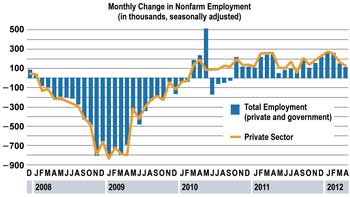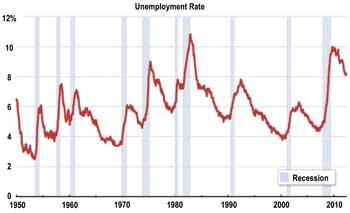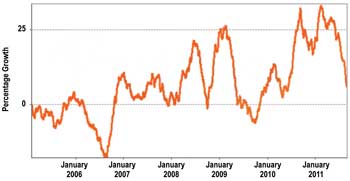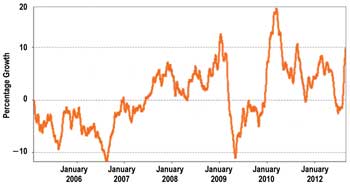Howard Rudzinsky, Louis Rudzinsky Associates
In today’s recovering economic climate, the outlook for jobs in photonics, optics and related disciplines is generally more favorable than it has been and is showing signs of continuing improvement, according to one longtime recruiter for the industry.
In the recent recession’s early days, photonics was affected in all segments: scientific, industrial, medical, defense, telecom, OEM. And the problem compounded itself when an employee of a commercial photonics company was laid off. That employee and family – because of a lack of income and the high costs of Cobra health insurance – often had to postpone elective procedures including lasik and cosmetic laser surgery, or minimally invasive procedures using some form of an optical scope (endoscope, arthroscope). This also affected the companies that manufactured those lasers and instruments as well as their engineers and suppliers.
The wars in Iraq and Afghanistan likely softened the impact, as it seemed that commercial nondefense companies in photonics and optics were hit harder. Some photonics people employed by nondefense companies migrated to the defense sector. As the wars continue to wind down and defense spending is being frozen in many areas, defense contractors have been laying off more people than nondefense companies.
As the economy has grown over the past three years, so has demand for commercial products, which means that the demand for employees is rising, too – commercial companies are hiring. So the migration now will go in the other direction, back toward commercial nondefense organizations. This is particularly true in optics and photonics. With orders for optical components and lasers from major aerospace companies diminishing – or contracts canceled – companies that rely heavily on those markets will suffer.
One of my good clients, a precision optics and coatings manufacturer, was almost at $50 million in sales two years ago. This year, it could be a $25 million to $30 million company. Who among us doesn’t have friends applying their photonics expertise to the defense community? The answer is none. We all do.
But major aerospace companies have had significant reductions over the past 12 to 18 months, with some acceleration in the past six. The US Department of Defense has committed to $350 billion in cuts over the next 10 years, and this number could and probably will grow. My view is that, with a few exceptions, defense will not be a growth area in optics and photonics until at least after the next presidential election.
However, even within defense there are a few bright spots, and these have photonics connections. For example, unmanned vehicles, including airborne and underwater, are used for sensing and sometimes weapons delivery. They are equipped with photonics-based imaging, laser, fiber optic sensing, control, guidance, targeting and reconnaissance systems. Military technology trends are moving toward less expensive unmanned platforms, and companies doing this work have jobs. Homeland security continues to be a strong area, and these same kinds of sensor systems – for border control or materials detection and analysis – will continue to be in demand. The US might not be as active in waging a war, but we will be ever vigilant looking for threats domestically and worldwide.
So this is recovery
As with many industries or disciplines, photonics and optics don’t feel completely recovered, do they? Ten-plus years after the dramatic expansion in photonics, fueled by the telecom bubble, those of us who enjoyed those heady times wonder when the recovery will really kick in.
The answer is that it probably will never feel like the previous photonics expansion. When will unemployment drop below 8, then 7 and 6 percent as the economy picks up steam and moves toward full employment again? For many, not soon enough. However, if you have been personally affected by this recession, as many of us have and continue to be, know that the economy is growing again.

Figure 1. Private payroll employment has grown for 27 months. Source: Bureau of Labor Statistics, Center on Budget and Policy Priorities.
“The United States went through its longest and, by most measures, worst economic recession since the Great Depression between December 2007 and June 2009,” according to the Center on Budget and Policy Priorities (see Figure 1). By most accounts, the “recovery” began in June 2009. Since that time the economy has grown private payroll employment for 27 straight months.
This is good news for everyone, including those of us who work in photonics-related areas. Not so fast, however – the economy must add 100,000 to 150,000 jobs per month just to keep up with the growth in population. So when you see the monthly jobs report, greater than 150,000 jobs is OK, but, really, more than 200,000 jobs should be added in a month to help cut into the jobs we lost. The economy lost between 6 and 8 million jobs (or more) in the recession, and recent accounts say that more than 4 million jobs have been created during the recovery. So, accounting for both population growth and replacing lost jobs, we might need 4 million to 6 million new jobs.

Figure 2. The unemployment rate is dropping again in all sectors. Source: Bureau of Labor Statistics, Center on Budget and Policy Priorities, and National Bureau of Economic Research.
And that is going to take some time. “The economy would have to create an average of 207,000 jobs each month for the next two years just to return to the December 2007 level of employment – and even more to restore full employment, since the population and potential labor force are now larger,” according to the Center on Budget and Policy Priorities (see Figure 2).
For those of us working in optics and photonics, this is our fifth recession since 1980. And this recession has felt the worst to many of us.

Figure 3. Optics-related jobs appear to be trending toward overall growth. Courtesy of Indeed.com.
That is our landscape, but it isn’t the whole picture by any means. Take a look at Figures 3 and 4, courtesy of Fergus Calderwood at Indeed.com. What is important to notice about these two charts, which simply look at the number of jobs captured by Indeed.com that have either the word “optics” or “laser” in them, is the trend line from post-2009 to the present. The slope of the curve is positive for a sustained period of more than two years.
This is encouraging to me and should be encouraging to everyone working in photonics.
Job growth has lagged somewhat behind the recovery, but remember that employment is a lagging, not leading, indicator. It is getting better. People are hiring. Keep this in mind.

Figure 4. Jobs in laser-related areas also show overall growth trends. Courtesy of Indeed.com.
Where the jobs are
So where are the jobs, and where do we go from here?
We’ll see continuing growth in commercial photonics and optics companies as the economy continues to recover, but let’s dig into this a little more deeply. As all segments of the industry recover, some areas merit further analysis, especially the uses of optics and photonics as enabling technologies in manufacturing.
One bright spot in the economy has been in manufacturing, believe it or not. The use of advanced manufacturing, including “lean” techniques, has become a growth area in all companies. Companies that implement lean manufacturing practices strive to expend resources only in the pursuit of adding value for customers, working to remove waste in all processes. More and more companies engaged in optics and photonics manufacturing are applying lean processes to engineering and to service-driven divisions. Companies engaged in developing automated test, positioning and advanced manufacturing – for example, multiaxis laser-based machining equipment – are all part of the growth in advanced lean manufacturing. Can you build it, test it, make it faster? Often, optical and photonics technologies can enable these things to happen better, quicker and more accurately. This is a growth area.
Energy development, exploration and production are major growth areas. Photonics plays a role in exploration and sensing as well as in development and manufacturing. This is another growth area.
Baby boomers and everyone else will need more and more medical care, and specialized technologies that include advanced imaging such as optical coherence tomography and minimally invasive surgical or diagnostic hardware/instrumentation will be in greater demand. We are a vain society, so cosmetic surgery applications, including many laser-based treatments for ophthalmology or dermatological care, are on the rise and will continue to increase. All of these need engineers to research, develop, test, manufacture, service and sell systems.
We also are an entertainment-driven society; new display and imaging components – both hardware and software – are all increasingly in demand. Think of the game systems that use optics to recognize your movements, or displays with higher resolution than high-definition coming out on tablets, phones and laptops – even the backup camera on your car. Optical and optoelectronic components and assemblies enable all of these. These are growth areas too.
Photonic and/or optoelectronic devices, including those with fiber optic components, are increasing in all aspects of our lives, from telecom to all the areas previously mentioned. Optoelectronics are vital and enable some photovoltaics, and of course alternative energy. Although solar use has increased, the solar, wind, wave revolution hasn’t overtaken fossil fuels yet, but they will find increasing application. And there are jobs here as well.
Meet the author
Howard Rudzinsky is president of Louis Rudzinsky Associates. He has provided contingency and retained search, recruitment and placement services to the photonics community nationwide since 1984. His company also provides talent acquisition and organizational consulting, and career counseling, contract recruitment and research services; email: [email protected]; web: www.lra.com